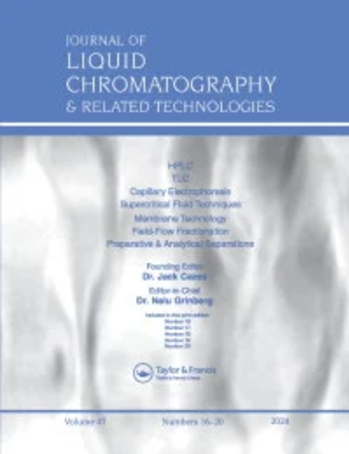Simultaneous determination of plasma indoles by HPLC with fluorescence detection: Application in polycystic ovary syndrome patients with/without depression
IF 1.2
4区 化学
Q4 BIOCHEMICAL RESEARCH METHODS
Journal of Liquid Chromatography & Related Technologies
Pub Date : 2022-02-25
DOI:10.1080/10826076.2022.2124267
引用次数: 0
Abstract
Abstract Microbiota-derived indoles were closely associated with psychological disorders like depression. We aimed to develop an HPLC method with fluorescence detection (FLD) for simultaneous determination of plasma indoles, including indoxyl sulfate (3-INDS), indole-3-acetic acid (IAA), indole-3-propionate (IPA), indole (IND) and 3-methylindole (3-MI). Diethyl ether and ethyl acetate were selected as the mixed extractant for the sample preparation. The separation was carried out on a Shim-Pack VP-ODS column (150 × 4.6 mm, 4.6 µm) with the mobile phase composed of 10 mmol/L sodium dihydrogen phosphate/methanol (40:60, v/v). The excitation and emission wavelengths were set at 280 and 355 nm, respectively. The linearities in plasma were obtained in the range of 1.56–400.0 μmol/L for 3-INDS, 0.312–10.0 μmol/L for IAA, 0.125–6.00 μmol/L for IPA, 6.25–400.0 nmol/L for IND, and 1.56–400.0 nmol/L for 3-MI, respectively. The coefficients of variation (CVs) for each analyte of the intra-day and inter-day precisions were within 4.0 and 5.2%, respectively. The recoveries were in the range of 90.1–109.3%. This sensitive and accurate method was applied to analyze plasma indoles for the diagnostic of depression in the patients with polycystic ovary syndrome (PCOS). Graphical Abstract荧光高效液相色谱法同时测定血浆吲哚:在多囊卵巢综合征伴/不伴抑郁患者中的应用
微生物源性吲哚与抑郁症等心理障碍密切相关。建立了同时测定血浆中吲哚(吲哚-3-乙酸(IAA)、吲哚-3-丙酸(IPA)、吲哚(IND)和3-甲基吲哚(3-MI)的高效液相色谱荧光检测方法。选择乙醚和乙酸乙酯作为混合萃取剂进行样品制备。色谱柱为Shim-Pack VP-ODS (150 × 4.6 mm, 4.6µm),流动相为10 mmol/L磷酸二氢钠/甲醇(40:60,v/v)。激发波长为280 nm,发射波长为355nm。血浆中3-INDS、IAA、IPA、IND和3-MI的线性范围分别为1.56 ~ 400.0 μmol/L、0.312 ~ 10.0 μmol/L、0.125 ~ 6.00 μmol/L、6.25 ~ 400.0 nmol/L和1.56 ~ 400.0 nmol/L。各分析物的日内、日间精密度变异系数(cv)分别在4.0%和5.2%以内。加样回收率为90.1 ~ 109.3%。该方法灵敏、准确,可用于多囊卵巢综合征(PCOS)患者血浆吲哚含量的分析。图形抽象
本文章由计算机程序翻译,如有差异,请以英文原文为准。
求助全文
约1分钟内获得全文
求助全文
来源期刊
CiteScore
2.80
自引率
0.00%
发文量
29
审稿时长
4.9 months
期刊介绍:
The Journal of Liquid Chromatography & Related Technologies is an internationally acclaimed forum for fast publication of critical, peer reviewed manuscripts dealing with analytical, preparative and process scale liquid chromatography and all of its related technologies, including TLC, capillary electrophoresis, capillary electrochromatography, supercritical fluid chromatography and extraction, field-flow technologies, affinity, and much more. New separation methodologies are added when they are developed. Papers dealing with research and development results, as well as critical reviews of important technologies, are published in the Journal.

 求助内容:
求助内容: 应助结果提醒方式:
应助结果提醒方式:


